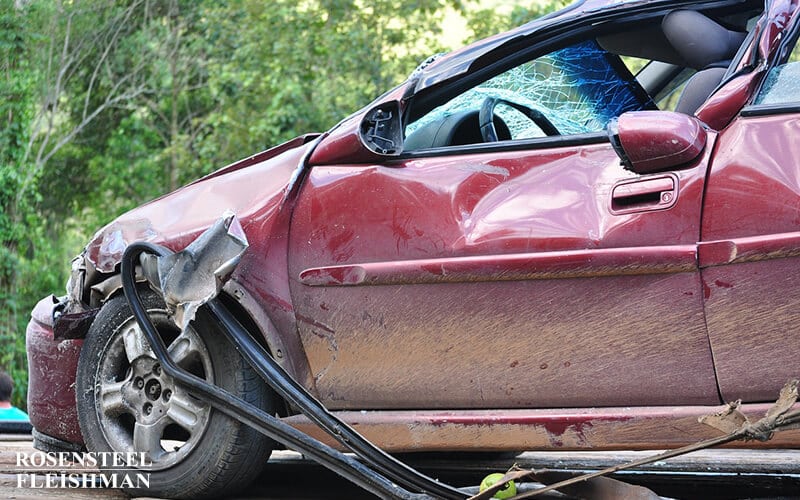After a car accident, many people feel unsure about what to do next, especially when injuries start affecting daily life. It is common to feel overwhelmed by medical appointments, insurance calls, and the overall strain the situation creates. When everything feels uncertain, having the support of a car accident law firm in Charlotte can make […]

Res Ipsa Loquitur in Car Accidents in North Carolina
We’ve talked about the doctrine of res ipsa loquitur before, in the medical malpractice context. However, North Carolina courts have also applied this doctrine in very limited circumstances to motor vehicle accidents.
Typically, in an action seeking damages for injuries arising out of a car accident, a plaintiff must allege the elements of negligence: (1) the defendant owed the plaintiff a duty to exercise reasonable care, (2) the defendant failed to exercise reasonable care, (3) the plaintiff suffered injuries, and (4) the defendant’s failure to exercise reasonable care both actually and proximately caused the plaintiff’s injuries.
However, in certain situations it can be difficult to prove the defendant’s failure to exercise reasonable care. For example, in the medical malpractice context, part of the rationale of applying the doctrine of res ipsa loquitur to certain facts is that the plaintiff is often unconscious and so cannot directly prove what caused his injury.
This is where the doctrine of res ipsa loquitur can come in. Literally, “res ipsa loquitur” means “the thing speaks for itself.” Under the doctrine, certain facts will give rise to a presumption of negligence, without a plaintiff having to directly show that the defendant failed to exercise reasonable care.
The North Carolina Supreme Court applied the doctrine of res ipsa loquitur in 1968 to a case involving a car accident, Greene v. Nichols. In Greene, Nichols was driving his car when he left his father-in-law’s house, his wife was in the front passenger seat, and another passenger was in the backseat. When the wrecked car was discovered, 3 ½ miles away from the father-in-law’s house, the wife and other passenger were in the same positions as when they left the house and Nichols “was on the ground beside the open door on the left side of the car.” No one survived the accident. The estate of the wife filed a claim against the estate of Nichols for pecuniary loss to her estate.
The court summarized the plaintiff’s evidence as follows:
The night was clear; the road was dry. The speed limit was 55 MPH, but the road was very crooked and hilly with very sharp curves. A highway sign warned Nichols, who was traveling west, that he was approaching a sharp curve. Furthermore, it is a fair inference from the evidence that Nichols was familiar with the road. On that curve, after crossing the eastbound lane and the south shoulder, he left the highway to collide head-on with a poplar tree five feet from the pavement. The automobile left no marks on the pavement or the shoulder. After the collision, the car spun around and came to rest 15 feet from the edge of the road. The tree was severely damaged; the vehicle demolished. The two passengers were killed instantly; the driver died soon thereafter.
In analyzing the evidence, the Court recognized that “[a]lmost invariably there is included an avowal that in North Carolina the doctrine of Res ipsa loquitur is not applicable to automobile accidents.” However, the Court reasoned that it is not required to “imagine possible explanations” when a car “leaves the highway for no apparent cause.” Instead, “[p]rima facie, it may accept the normal and probable one of driver-negligence and leave it to the jury to determine the true cause after considering all the evidence--that of defendant as well as plaintiff.”
The Court acknowledged that this reasoning meant that they “applied the doctrine of Res ipsa loquitur, which simply means that the nature of the occurrence itself furnishes circumstantial evidence of driver-negligence.” The Court stated that “[t]he inference of negligence does not arise from the mere fact of injury.” Instead, “it arises from the manner in which it occurred.” Because “[i]t is unusual for an automobile to leave the highway,” the Court reasoned that “[w]hen it does so without apparent cause and inflicts injury or damage, an inference of the driver's actionable negligence arises, which will take the case to the jury.”
In choosing to apply the doctrine of res ipsa loquitur, the Court reviewed a summary from A.L.R. about the doctrine of res ipsa loquitur:
Automobile accidents * * * happen under a large variety of circumstances which as a rule involve the fault of more than one person and the cases are rare in which only one inference may be drawn from the happening as being more plausible than others. Consequently, automobile accidents, taken as a group, do not represent the typical occurrence to which the res ipsa loquitur doctrine applies. However, there is no doubt but that the doctrine may be applied to an automobile accident if a proper case is presented. In other words, the mere fact that the occurrence is an automobile accident does not ipso facto exclude the availability of the doctrine * * * Among the various types of automobile accidents there is at least one in which the res ipsa loquitur doctrine has been applied with appreciable consistency. Where a motor vehicle leaves the roadway without a prior collision and thereby causes injury or damage, the courts, as a general rule, are prepared to draw an inference of negligence from the occurrence, assuming, of course, that all the other conditions of applicability are met.
The Court also looked at Prosser’s statement regarding the doctrine:
The requirement for the application of the doctrine of Res ipsa loquitur 'that the occurrence be one which ordinarily does not happen without negligence is of course only another way of stating an obvious principle of circumstantial evidence: that the event must be such that in the light of ordinary experience it gives rise to an inference that some one must have been negligent. On this basis res ipsa loquitur has been applied to a wide variety of situations, and its range is as broad as the possible events which reasonably justify such a conclusion. It finds common application, for example, in * * * some kinds of automobile accidents, such as a car suddenly leaving the highway and going into the ditch or colliding with a stationary object, or starting down hill not long after it has been parked at the curb.'
The Court in Greene then concluded that the driver of the car was negligent.
Since Greene, North Carolina courts have only applied the doctrine of res ipsa loquitur to car accidents in very limited circumstances. Recently, in a 2007 unpublished North Carolina Court of Appeals case, Henderson v. Henderson, the court of appeals refused to apply the doctrine of res ipsa loquitur to a car accident case. In Henderson, the defendant picked up the plaintiff at her home. Shortly thereafter, the defendant rounded a curve, lost control of the car and hit a telephone pole. At trial, the defendant testified that as she rounded the curve “[her] vehicle locked up and cut off.” However, a licensed vehicle appraiser inspected the vehicle after the crash and his “visual inspection showed the brakes and steering to be in working order.”
The plaintiff relied on the case Drumwright v. Wood, which the North Carolina Supreme Court decided in 1966. In Drumwright, the car was found down an embankment, the road was dry, there was nothing on the road where the car left the road, and immediately prior to the accident people in the vicinity heard “a loud roar and a big thud or bump.” The driver died as a result of injuries sustained in the accident. The Court “found this evidence permitted inferences that the plaintiff's husband (1) failed to decrease the speed of the vehicle when approaching a curve in the road; (2) operated the vehicle in excess of the speed limit; (3) operated the vehicle recklessly; and (4) failed to keep a proper lookout.”
The court of appeals distinguished Drumwright from Henderson because the driver in Henderson was able to offer an account of what happened immediately preceding the accident, namely that the car locked up. In contrast, the driver in Drumwright was killed and could not provide an account of what happened prior to the accident. Therefore, res ipsa loquitur was not applicable and plaintiff was required “to plead and prove facts which constitute[d] negligence.”
If you have been injured in a car accident, visit www.rflaw.net for legal help.
Additional Car Accident Articles
When a car accident leads to paralysis, the impact reaches every part of life. Daily routines suddenly feel different, and the simplest decisions can feel heavier than before. Many people in this situation look for clarity about what comes next and how to handle the financial and physical stress that follows. It can be difficult […]
When someone is dealing with a broken arm after a crash, it is common to feel unsure about the next steps. Pain, medical appointments, and unexpected bills can make everything feel overwhelming. Many people are surprised by how quickly daily routines change, especially when their injury affects work, driving, or caring for their families. During […]
After a crash, many people feel a mix of confusion, worry, and frustration, especially when injuries begin to set in or the reality of the damage becomes clear. It is common to feel unsure about what to do next or how to protect yourself. Even simple tasks can feel overwhelming when you are dealing with […]
